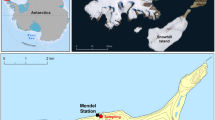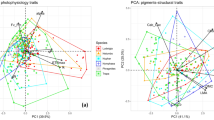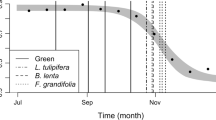Abstract
Photosynthesis, chlorophyll fluorescence, and hyperspectral reflectance were used to evaluate diurnal changes of Elaeagnus umbellata to quantify physiological responses of the invasive species during times of stress. Field measurements showed that E. umbellata is able to maintain higher levels of photosynthesis relative to nearby Quercus alba plants, with less water loss. Plants subjected to progressive drought were able to recover photosynthesis one day following re-watering. Laboratory and field measurements revealed decreasing ΔF/F′m values in response to drought stress, with little corresponding decrease in photochemical reflectance index values. This research supports the view that xanthophyll cycle dissipation is not the photoprotective mechanism at work for Elaeagnus species under water stress. Elaeagnus umbellata maintains photosynthetic carbon assimilation even under drought conditions, in part, due to chemical dissipation of excess light, and in part because of morphological features that limit excess radiation while maximizing photosynthetic carbon gain. These characteristics may contribute to the invasive success of E. umbellata.







Similar content being viewed by others
References
Ahmad SD, Sabir SM, Zubair M (2006) Ecotypes diversity in autumn olive (Elaeagnus umbellata Thunb): a single plant with multiple micronutrient genes. Chem Ecol 22:509–521
Apel K, Hirt H (2004) Reactive oxygen species: metabolism, oxidative stress and signal transduction. Annu Rev Plant Biol 55:373–399
Baruch Z, Goldstein G (1999) Leaf construction cost, nutrient concentration, and net CO2 assimilation of native and invasive species in Hawaii. Oecologia 121:183–192
Bellot J, Maestre FT, Hernández N (2004) Spatio-temporal dynamics of chlorophyll fluorescence in a semi-arid Mediterranean shrubland. J Arid Environ 58:295–308
Benítez-Malvido J, Martínez-Ramos M (2002) Impact of forest fragmentation on understorey plant species richness in Amazonia. Conserv Biol 17:389–400
Bilger W, Björkman O, Thayer SS (1989) Light-induced spectral absorbance changes in relation to photosynthesis and the epoxidation state of xanthophyll cycle components in cotton leaves. Plant Physiol 91:542–551
Brantley ST, Young DR (2009) Linking light attenuation, sunflecks and canopy architecture in mesic shrub thickets. Plant Ecol. doi:10.1007/s11258-009-9637-9
Bruno JF, Fridley JD, Bromberg KD, Bertness MD (2005) Insights into biotic interactions from studies of species invasions. In: Sax DF, Stachowicz JJ, Gaines SD (eds) Species invasions: insights into ecology, evolution, and biogeography. Sinauer Associates, Sunderland
Chaves MM, Pereira JS, Maroco J, Rodrigues ML, Ricardo CPP, Osório ML, Carvalho I, Faria T, Pinheiro C (2002) How plants cope with water stress in the field. Photosynthesis and growth. Ann Bot 89:907–916
Côté B, Carlson RW, Dawson JO (1988) Leaf photosynthetic characteristics of seedlings of actinorhizal Alnus spp. and Elaeagnus spp. Photosynth Res 16:211–218
Demmig-Adams B, Adams WW III (1992) Photoprotection and other responses of plants to high light stress. Annu Rev Plant Physiol Plant Mol Biol 43:599–626
Demmig-Adams B, Adams WW III (1996) The role of xanthophyll cycle carotenoids in the protection of photosynthesis. Trends Plant Sci 1:21–26
Ebinger J, Lehnen L (1981) Naturalized autumn olive in Illinois. Trans Ill Acad Sci 74:83–85
Ehleringer J (1982) The influence of water stress and temperature on leaf pubescence development in Encelia farinosa. Am J Bot 69:670–675
Ehleringer J, Björkman O (1978) Pubescence and leaf spectral characteristics in a desert shrub, Encelia farinosa. Oecologia 36:151–162
Ehleringer J, Mooney HA (1978) Leaf hairs: effects on physiological activity and adaptive value to a desert shrub. Oecologia 37:183–200
Ehleringer J, Björkman O, Mooney HA (1976) Leaf pubescence: effects on absorptance and photosynthesis in a desert shrub. Science 192:376–377
Evain S, Flexas J, Moya I (2004) A new instrument for passive remote sensing: 2. Measurement of leaf and canopy reflectance changes at 531 nm and their relationship with photosynthesis and chlorophyll fluorescence. Remote Sens Environ 91:175–185
Flexas J, Medrano H (2002) Energy dissipation in C3 plants under drought. Funct Plant Biol 29:1209–1215
Flexas J, Escalona JM, Evain S, Gulías J, Moyam I, Osmond CB, Medrano H (2002) Steady-state chlorophyll fluorescence (Fs) measurements as a tool to follow variation of net CO2 assimilation and stomatal conductance during water-stress in C3 plants. Physiol Plant 114:231–240
Gamon JA, Peñuelas J, Field CB (1992) A narrow-waveband spectral index that tracks diurnal changes in photosynthetic efficiency. Remote Sens Environ 41:35–44
Gong JR, Zhao AF, Huang YM, Zhang XS, Zhang CL (2006) Water relations, gas exchange, photochemical efficiency, and peroxidative stress of four plant species in the Heihe drainage basin of northern China. Photosynthetica 44:355–364
Hufbauer RA, Torchin ME (2007) Integrating ecological and evolutionary theory of biological invasions. In: Nentwig W (ed) Biological invasions. Springer, Berlin
Huynh H, Feldt LS (1976) Estimation of the box correction for degrees of freedom for sample data in randomized block and split plot designs. J Educ Stat 1:69–82
Katz GL, Shafroth PB (2003) Biology, ecology and management of Elaeagnus angustifolia L. (Russian olive) in western North America. Wetlands 23:763–777
Klich MG (2000) Leaf variations in Elaeagnus angustifolia related to environmental heterogeneity. Environ Exp Bot 44:171–183
Levizou E, Drilias P, Psaras GK, Manetas Y (2005) Nondestructive assessment of leaf chemistry and physiology through spectral reflectance measurements may be misleading when changes in trichome density co-occur. New Phytol 165:463–472
Morales F, Abadía A, Abadía J, Montserrat G, Gil-Pelegrín E (2002) Trichomes and photosynthetic pigment composition changes: responses of Quercus ilex subsp. Ballota (Desf.) Samp. and Quercus coccifera L. to Mediterranean stress conditions. Trees 16:504–510
Nestleroad J, Zimmerman D, Ebinger J (1987) Autumn olive reproduction in three Illinois state parks. Trans Ill Acad Sci 80:33–39
Ruban AV, Young AJ, Horton P (1993) Induction of nonphotochemical energy dissipation and absorbance changes in leaves. Plant Physiol 102:741–750
Suthers HB, Bickal JM, Rodewald PG (2000) Use of successional habit and fruit resources by songbirds during autumn migration in central New Jersey. Wilson Bull 112:249–260
Von Ende CN (1993) Repeated-measures analysis: growth and other time- dependent measures. In: Scheiner SM, Gurevitch J (eds) Design and analysis of ecological experiments. Chapman & Hall, New York
Winkel T, Méthy M, Thénot F (2002) Radiation use efficiency, chlorophyll fluorescence, and reflectance indices associated with ontogenic changes in water limited Chenopodium quinoa leaves. Photosynthetica 40:227–232
Yates ED, Levia DP Jr, Williams CL (2004) Recruitment of three non-native invasive plants into a fragmented forest in southern Illinois. Forest Ecol Manag 190:119–130
Zar JH (1999) Biostatistical analysis. Prentice Hall, Inc, New Jersey
Zhao CM, Wang GX, Wei XP, Deng JM, Cheng DL (2007) Effects of groundwater depth variation on photosynthesis and photoprotection of Elaeagnus angustifolia L. Trees 21:55–63
Acknowledgments
The authors thank Cody Connolly, Sheri Shiflett, and Ellen Young for help with field and laboratory measurements. This research was support by a grant to DRY from the United States Army Research Office. This research was also supported in part by an appointment to the Postgraduate Research Participation Program at the U.S. Army Corps of Engineers/Engineer Research and Development Center (ERDC) administered by the Oak Ridge Institute for Science and Education through an interagency agreement between the US Department of Energy and ERDC.
Author information
Authors and Affiliations
Corresponding author
Additional information
Communicated by E. Beck.
Rights and permissions
About this article
Cite this article
Naumann, J.C., Bissett, S.N., Young, D.R. et al. Diurnal patterns of photosynthesis, chlorophyll fluorescence, and PRI to evaluate water stress in the invasive species, Elaeagnus umbellata Thunb.. Trees 24, 237–245 (2010). https://doi.org/10.1007/s00468-009-0394-0
Received:
Revised:
Accepted:
Published:
Issue Date:
DOI: https://doi.org/10.1007/s00468-009-0394-0




